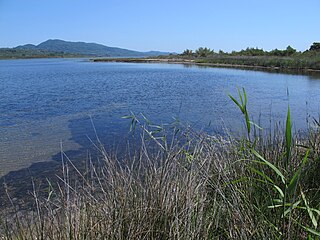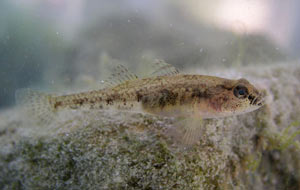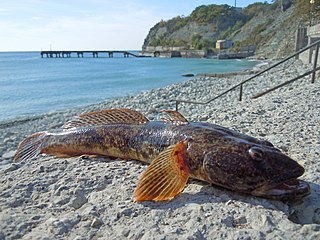
Knipowitschia caucasica, the Caucasian dwarf goby, is a species of goby native to marine, fresh and brackish waters along the coasts of the Black Sea, the Sea of Azov, the Caspian Sea and the Aegean Sea and to the Haliacmon drainage of Greece. It inhabits shallow waters with plentiful weed growth where it can find its prey consisting of small crustaceans, the larvae of chironomids and the larvae of the mussel Dreissena polymorpha. Spawning takes place after their first winter with the eggs being deposited onto the roof of a cavity formed by rocks, shells or plant materials. The male will remain to defend the eggs. This species can reach a length of 5 centimetres (2.0 in) TL

Knipowitschia is a genus of marine, fresh and brackish water gobies native to Eurasia. The genus name almost certainly honours Nikolai Mikhailovich Knipovich (1862-1938), a biologist who led a number of expeditions to the Caspian Sea.
Knipowitschia croatica, the Neretva dwarf goby, is a species of fresh water ray-finned fish from the family Gobiidae. It is endemic to the western Balkans occurring in the Neretva drainage in Bosnia and Herzegovina and in Croatia in the Matica drainage, Neretva springs and Baćina lakes. This species can reach a length of 4.7 centimetres (1.9 in) SL.
Knipowitschia ephesi, the Ephesus goby, is a species of goby endemic to the delta and marshes of the lowermost Küçük Menderes in western Anatolia, Turkey.Turkey where it occurs in stagnant or nearly stagnant fresh waters. Its habitat is threatened by water abstraction, pollution, and destruction and these have an impact on this species, leading to the IUCN to classify it as Critically Endangered. The specific name refers to the ancient, ruined city of Ephesus which was a port located at mouth of the Küçük Menderes.

Knipowitschia goerneri, the Corfu dwarf goby, is a species of freshwater goby endemic to the island of Corfu in western Greece. This species can reach a length of 2.2 centimetres (0.87 in) SL. This species was only recorded from a single spring and was considered to have been last recorded in 1983 but surveys in the 1990s failed to find any, it was incorrectly thought that the spring which was the type locality had been affected by water abstraction which may have caused an increase in salinity, but the species had not been recorded at the affected spring. In 2014, nine specimens of Corfu dwarf goby were collected from Korission Lagoon in southern Corfu. The specific name honours Manfred Görner, who supported the author's ichthyological research.
Knipowitschia mermere is a species of fresh water goby endemic to Lake Marmara and the associated basin of the River Gediz in Turkey where it can be found in shallow, poorly oxygenated water with plentiful weed growth. This species can reach a length of 2.4 centimetres (0.94 in) TL.
Knipowitschia milleri, the Acheron Spring goby, is a species of goby endemic to Greece where it can be found in nearly stagnant, clear, fresh to very slightly brackish waters with abundant weed growth. This species can reach a length of 2.6 centimetres (1.0 in) SL.

Knipowitschia panizzae, the Adriatic dwarf goby, is a species of goby native to the coasts of the Adriatic and Ionian Seas where it has been recorded in Italy, Slovenia and Croatia with records from Greece needing to be confirmed. It prefers fresh and brackish waters with plentiful vegetation. This species can reach a length of 5.5 centimetres (2.2 in) TL. It is not known who the specific name honours but it is thought likely to be the Italian anatomist Bartolomeo Panizza (1785-1867), who studied the post-reproductive mortality of male sea lampreys.

Knipowitschia punctatissima, the Italian spring goby, is a species of goby endemic to Italy where it inhabits fresh, clear waters of springs, streams, and channels with slow water movements. This species can reach a length of 4.5 centimetres (1.8 in) SL.
Knipowitschia thessala, the Thessaly goby, is a species of goby endemic to the Pineios River system in Thessaly, Greece. This species can reach a length of 4.4 centimetres (1.7 in) TL.

Mesogobius batrachocephalus, the knout goby or toad goby, is one of the species of gobiid fish native to the Black Sea and the Sea of Azov basins. It lives in estuaries and brackish water lagoons, occasionally in fresh waters, such as the coastal Lake Siutghiol in Romania. It prefers areas near cliffs with sandy, shelly or rocky substrates at depths of from 20 to 60 metres, sometimes down to 100 metres (330 ft). The knout goby is a piscivore. It can reach a length of 34.5 centimetres (13.6 in) SL and weight of 600 grams (1.3 lb). Maximum known age is eight years.

The Syrman goby is a species of goby native to marine, brackish and probably fresh waters of the Black Sea, the Sea of Azov and the Caspian Sea basins. They inhabit inshore waters with substrates composed of shell fragments, sand, mud or muddy sand. This species can reach a length of 24.5 centimetres (9.6 in) TL.

The stellate tadpole-goby is a species of gobiid fish native to the basin of the Sea of Azov where it occurs in the Gulf of Taganrog and limans of the eastern coast. It also lives in the lower Don River up to the Tsimlyansk Reservoir. It occurs in fresh and brackish waters of depths greater than 3 metres (9.8 ft), preferring shallow coastal lagoons and lowland rivers. Males can reach a length of 13.5 centimetres (5.3 in) TL while females only reach 11 centimetres (4.3 in) TL.
Knipowitschia cameliae, the Danube delta dwarf goby, is a species of goby known only from the brackish and fresh waters of a lagoon south of the Danube Delta in Romania. This fish is a shallow water species being found in waters less than 1 metre (3.3 ft) deep. This species can reach a length of 3.2 centimetres (1.3 in) SL. This species has been assessed by the IUCN as Critically Endangered, possibly extinct, it was last recorded in 1994 and surveys in that year and 1998 have failed to record the species. The specific name honours Camelia Iliana Nalbant, the wife of the senior author.
Knipowitschia radovici, the Norin goby, is a species of goby endemic to Croatia where it only occurs in the drainage basin of the Neretva River where adults inhabit the deepest parts of the rivers in the strongest current. This species can reach a length of 2.8 centimetres (1.1 in) SL. The specific name honours the Ornithologist Dragan Radović, a friend of the author, Marcelo Kovačić, who encouraged him to sample in the waterbodies of Croatia.
Knipowitschia mrakovcici is a species of freshwater goby Endemic to the Krka River catchment in Croatia where it is only found in lakes. Males of this species can reach a length of 3.2 centimetres (1.3 in) SL while females only reach 2.8 centimetres (1.1 in) SL. The specific name honours the Croatian biologist Milorad Mrakovčić of the University of Zagreb, who provided the author, Peter J. Miller, with the original type material.
Knipowitschia iljini is a species of goby Endemic to the Caspian Sea, where it inhabits the deep waters in the central part. This species can reach a length of 4.7 centimetres (1.9 in) TL. The specific name honours the taxonomist of Gobiiformes Boris Sergeevich Iljin (1889-1958), who researched the gobies of the Black and Caspian seas.
Hyrcanogobius bergi, the Volga dwarf goby, is a species of goby endemic to the Caspian Sea where it occurs in fresh, brackish and marine waters along the coast. Unusually for gobies, this species is almost a pelagic fish. This species grows to a length of 3.6 centimetres (1.4 in) SL. This species is the only known member of its genus. The specific name honours the Soviet zoologist Lev Berg (1876-1950) who described many new species of goby from the Caspian Sea.
Knipowitschia byblisia, the Byblis goby, is a species of ray-finned fish from the family Gobiidae which is endemic to a single lake in western Anatolia. This species is endemic to Lake Köycegiz, a brackish lake in eastern Anatolia near the Aegean Sea. The lake is a protected and the species is abundant within the lake so the IUCN have classified K. byblis as Least Concern. The specific name references the mythological figure Byblis, who was the twin sister of Caunos, the legendary founder of the ancient city Kaunos, the ruins of which are situated on the southwest Anatolian coast; near to Lake Köycegiz.
Knipowitschia caunosi, the Caunos goby or Köycegiz dwarf goby, is a species of ray-finned fish from the family Gobiidae which is endemic to a single lake in western Anatolia. This species is endemic to Lake Köycegiz, a brackish lake in eastern Anatolia near the Aegean Sea. The lake is a protected and the species is abundant within the lake so the IUCN have classified K. caunosi as Least Concern. The specific name references the mythological figure Caunos, who was the twin sister of Byblis, in legend his sister fell in love with him and he fled to avoid committing incest, founding the ancient city Kaunos in Caria, the ruins of which are situated on the southwest Anatolian coast; near to Lake Köycegiz.










